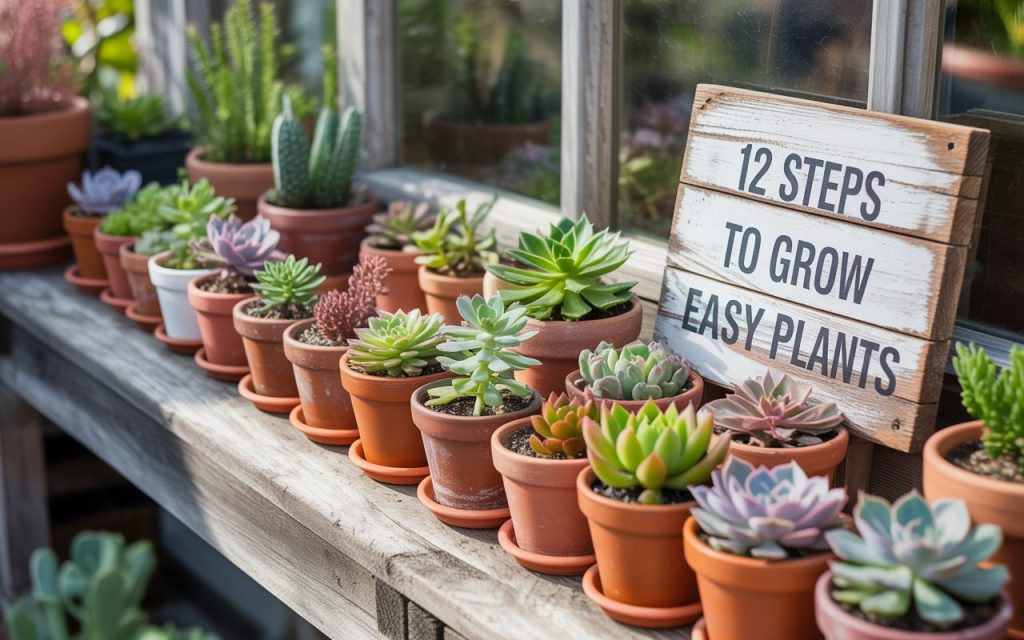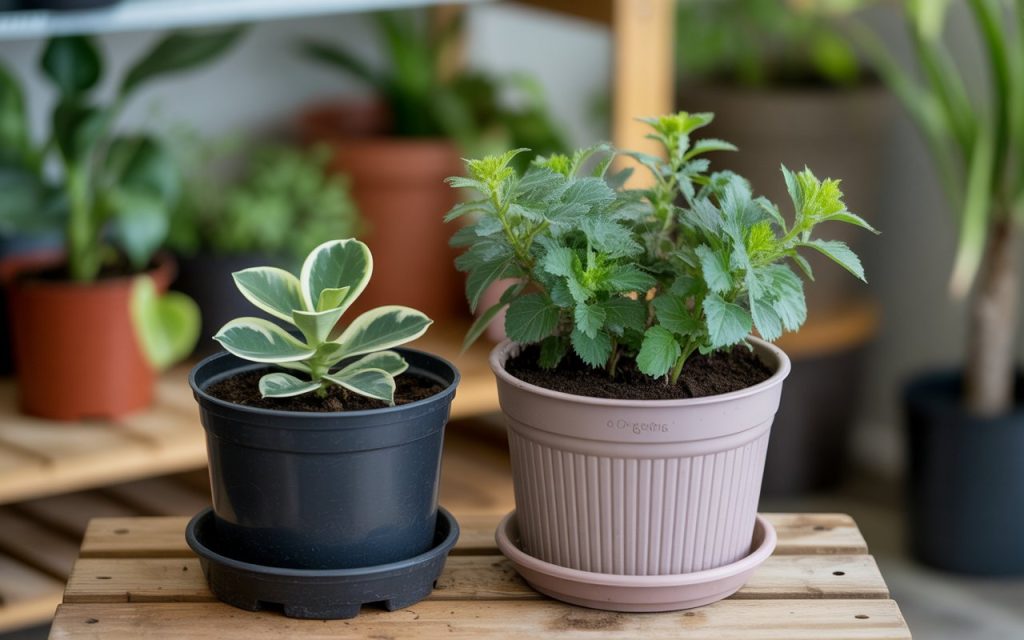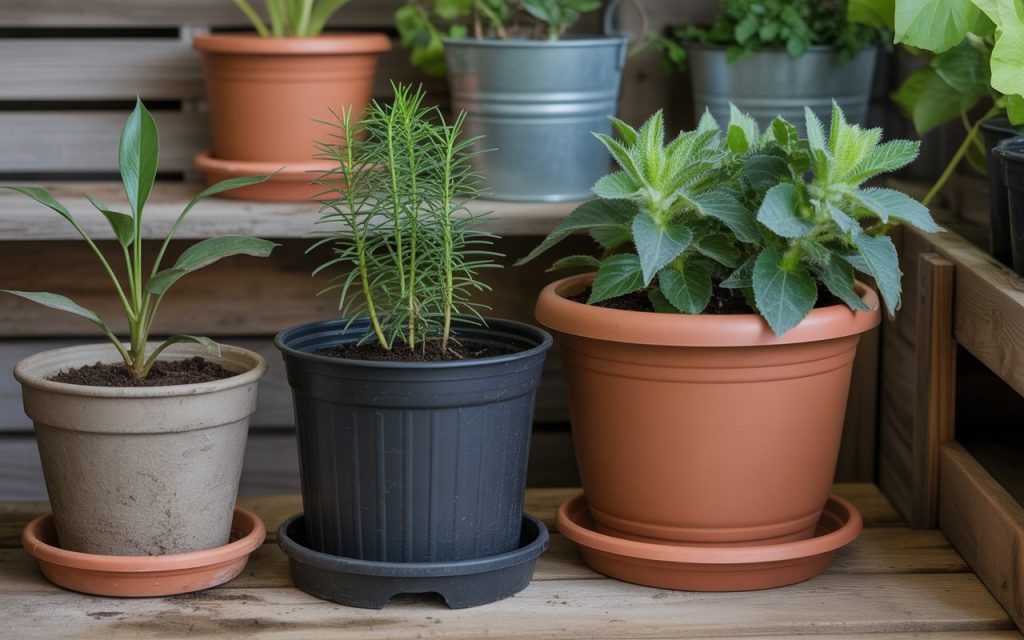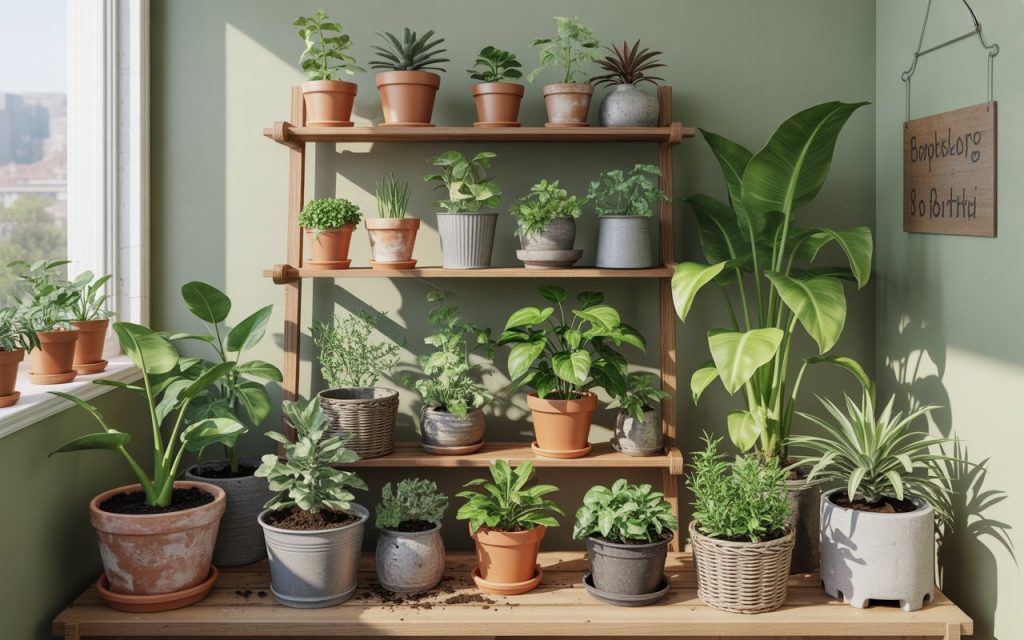Starting a garden can feel overwhelming for beginners. That’s why choosing easy plants to take care of makes the process enjoyable and rewarding. These plants are hardy, adaptable, and forgiving, even if you occasionally forget to water them. Plus, they help you learn the basics of sunlight, watering, soil, and pest management without requiring advanced skills.

Step 1: Choose Beginner-Friendly Plants
Top 5 Indoor Plants for Beginners
- Snake Plant (Sansevieria): Tolerates neglect, low light, and irregular watering.
- Spider Plant (Chlorophytum): Grows quickly and thrives in indirect sunlight.
- Pothos (Epipremnum aureum): Nearly indestructible and can grow in water or soil.
- ZZ Plant (Zamioculcas zamiifolia): Requires minimal care and survives in low-light conditions.
- Peace Lily (Spathiphyllum): Known for air purification and easy maintenance.
Best Outdoor Plants for Beginners
- Marigolds: Bright, colorful, and pest-resistant.
- Basil: Hardy herb, perfect for beginners who also love cooking.
- Sunflowers: Simple to grow and ideal for learning plant growth cycles.
- Aloe Vera: Low-water succulent with medicinal benefits.
- Mint: Spreads easily and grows well in most conditions.
Step 2: Select the Right Location
Importance of Sunlight and Shade
Plants need varying levels of sunlight, some thrive in full sun, while others prefer shade. For example:
- Full Sun Plants: Tomatoes, sunflowers, basil.
- Partial Shade Plants: Ferns, lettuce, coleus.
- Low Light Plants: Snake plant, ZZ plant.
Creating an Indoor Plant-Friendly Environment
- Place plants near south-facing windows for maximum sunlight.
- Use grow lights if natural light is limited.
- Ensure proper air circulation to prevent fungal growth.
Step 3: Prepare the Soil Properly
Soil is the foundation of any successful gardening journey. Beginners often underestimate its importance, but healthy soil provides the right nutrients, structure, and drainage for plants to thrive. Without good soil, even the easy plants to take care of may struggle.
Understanding Soil Types
There are three main soil types, and each one influences how plants grow:
- Sandy Soil: Drains quickly but doesn’t hold nutrients well. Great for herbs like rosemary and lavender.
- Clay Soil: Rich in nutrients but often too dense, leading to poor drainage. Works well for vegetables like broccoli and cabbage if amended.
- Loamy Soil: The ideal balance of sand, silt, and clay, perfect for most beginner plants.
Tip: Beginners should aim for loamy soil, as it retains moisture without becoming waterlogged.
Adding Compost and Fertilizers
Compost improves soil texture, increases fertility, and introduces beneficial microorganisms. You can create compost at home using:
- Vegetable scraps
- Coffee grounds
- Dry leaves
- Grass clippings
When using fertilizers, stick to slow-release organic options like bone meal, fish emulsion, or worm castings. These feed plants gradually and reduce the risk of overfertilizing.
Step 4: Learn the Basics of Watering
Watering may sound simple, but it’s one of the most common areas where beginners go wrong. Some plants die from overwatering rather than neglect.
How Often Should You Water Plants?
- Indoor Plants: Usually once a week, depending on humidity and pot size.
- Outdoor Plants: Water early in the morning or late evening, about 2–3 times per week.
- Succulents & Cacti: Once every 2-3 weeks, as they store water in their leaves.
Signs of Overwatering and Underwatering
- Overwatering: Yellowing leaves, mushy stems, root rot.
- Underwatering: Dry, crispy leaves, drooping stems, slow growth.
💡 Golden Rule: Stick your finger one inch into the soil. If it feels dry, it’s time to water.

Step 5: Use the Right Pots and Containers
The right container can make or break your plant’s growth. For beginners, plastic or ceramic pots with drainage holes are the easiest choice.
Drainage Matters
Drainage holes prevent excess water from suffocating the roots. Without them, plants risk developing root rot.
Choosing Pot Sizes
- Small Pots (4–6 inches): Herbs, succulents, or small flowers.
- Medium Pots (8–12 inches): Spider plants, pothos, and peace lilies.
- Large Pots (14+ inches): Small trees, sunflowers, or bushy herbs like mint.
Pro Tip: Start small. Oversized pots hold too much water, which can harm young plants.
Step 6: Start Small and Expand Gradually
Many beginners get excited and buy too many plants at once. While enthusiasm is great, managing too many plants can become overwhelming.
- Begin with 2–3 easy plants to take care of (like snake plant, pothos, or basil).
- Once you gain confidence, add more varieties.
- Keep a plant journal to track watering, fertilization, and growth.
This way, you’ll avoid burnout and ensure your plants get the attention they deserve.
Step 7: Understand Light Requirements
Understanding light is one of the biggest shortcuts to success with easy plants to take care of. Light affects photosynthesis, bloom timing, leaf color, and overall health, so you’ve got to match the plant to the light you actually have.
How much light do common plants need?
- Full sun (6+ hours/day): Many outdoor vegetables (tomatoes, peppers) and sun-loving flowers.
- Partial sun/partial shade (3–6 hours/day): Most herbs and many patio plants.
- Low light (less than 3 hours/day or bright indirect light): Snake plant, ZZ plant, pothos, great indoor starters.
Practical tips you can use right away
- Put succulents and herbs near a south- or west-facing window if you have one.
- Shade-loving plants do well on north- or east-facing windows or a few feet back from bright windows.
- If natural light’s limited, use grow lights on a timer (12–14 hours/day for many houseplants). You don’t need fancy gear, simple LED grow strips work fine.
- Rotate pots every week so plants don’t lean toward the light.
Quick check: If leaves are pale or stretched toward the window, the plant’s asking for more light. If leaf tips burn or the soil dries unusually fast, it might be getting too much direct sun.
Step 8: Fertilize at the Right Time
Fertilizer gives plants the nutrients they need beyond what soil naturally provides. But timing and type matter, too much, too often will do more harm than good.
What fertilizer to choose
- For beginners, a balanced, slow-release organic fertilizer (e.g., 10-10-10 or 14-14-14 labeled for general garden use) is forgiving.
- For indoor foliage plants, a diluted liquid fertilizer every 4–6 weeks during the growing season is a safe bet.
- Use a low-nitrogen fertilizer for flowering plants once buds form to encourage blooms rather than leaf growth.
When to feed
- Spring and early summer are prime feeding times, plants are actively growing and will use nutrients quickly.
- Reduce or stop feeding in autumn and winter when most plants slow down.
- Always follow label instructions, but when in doubt, feed at half strength.
A simple routine to follow
- Seedlings & young plants: light feeding once every 4–6 weeks.
- Established container plants: slow-release at potting time + diluted feed mid-season.
- Outdoor beds: add compost yearly and feed vegetable/flower beds during active growth.

Step 9: Prune and Trim Regularly
Pruning is not only for looks, it improves airflow, directs energy to healthy growth, and can prevent pests and disease.
Basic pruning rules for beginners
- Remove dead or yellowing leaves immediately. They attract pests and hide disease.
- For leggy plants, pinch back tips to encourage bushier growth. This works great with herbs like basil and houseplants like coleus.
- For flowering plants, deadhead (remove spent blooms) to encourage more flowers.
- For outdoor shrubs, prune lightly after flowering or in the dormant season, following species-specific guidance.
Tools and safety
- Use clean, sharp pruning shears, dull tools tear tissue and welcome disease.
- Sterilize blades between plants when disease or pests are present (rubbing alcohol works).
- Don’t remove more than one-third of a healthy plant at once, that stresses it.
Step 10: Protect Plants from Pests and Diseases
Even easy plants to take care of can get pests. The goal is to prevent problems and treat them early.
Common garden and houseplant pests
- Aphids, mealybugs, spider mites, scale, slugs/snails (outdoors), and fungal issues like powdery mildew or root rot.
Natural remedies vs. chemicals
- Natural first: Hand-pick pests, wash leaves with water, use insecticidal soap or a neem oil spray. These options are gentle and safe for beginners.
- Chemical controls: Reserved for severe infestations where natural methods fail. Always read labels and follow safety guidance, don’t use harsh garden chemicals indoors where people or pets spend time.
Integrated Pest Management (IPM) – a simple approach
- Prevent: Keep plants healthy, remove debris, and quarantine new plants for a week.
- Monitor: Inspect plants weekly, look under leaves and at leaf bases.
- Respond: Use the least-toxic method that works (water spray, soap, neem) first.
- Record: Note what worked in your plant journal for next time.
Step 11: Be Consistent with Plant Care
Consistency beats perfection. A small routine you keep every week will take you much further than occasional intense care.
Build a simple care routine
- Weekly check (15–20 minutes): Water if soil is dry, trim dead leaves, and check for pests.
- Monthly: Rotate plants, feed if in growing season, inspect drainage.
- Every season: Re-pot if roots are crowded, refresh topsoil or add compost to outdoor beds.
Tools to help you stay consistent
- Use a calendar or smartphone reminders for watering and fertilizing.
- Keep a plant journal with photos, you’ll notice patterns (e.g., this plant droops after 3 days without water).
- Join a local gardening group or forum for timely reminders and community tips.

Step 12: Track Progress and Keep Learning
Gardening is a learning loop: try, observe, adjust. Tracking helps you learn what works in your home or garden climate.
How to track effectively
- Note the plant name, variety, pot size, light spot, watering schedule, and fertilization in a simple log or spreadsheet.
- Take monthly photos, visual records show growth or decline better than memory.
- Record mistakes too, they’re often the fastest teachers.
Resources to keep growing
- Horticultural extension services and reputable gardening organizations offer science-backed advice. For general best practices, the Royal Horticultural Society has helpful guides.
- Experiment gradually: change only one thing at a time (e.g., move a plant to a brighter window) and observe results for a couple of weeks.
Quick Reference Table – Watering & Light Cheat Sheet
| Plant Type | Light Preference | Typical Watering |
|---|---|---|
| Succulents/Cacti | Bright light, some direct sun | Every 2–3 weeks |
| Herbs (basil, mint) | 4–6 hours sun | Twice a week (more when hot) |
| Foliage houseplants (ZZ, pothos) | Bright indirect to low | Once a week or when top 1″ dry |
| Flowering annuals | Full to partial sun | 2–3 times per week (varies) |
Frequently Asked Questions (FAQs)
For indoors: snake plant, pothos, spider plant, and ZZ plant. For outdoors: marigolds, basil, sunflowers, and mint. These handle a range of light and watering conditions and forgive beginner mistakes.
Most houseplants need repotting every 1–2 years. Repot when roots show at drainage holes or the plant looks root-bound. Choose a pot one size larger and refresh the potting mix.
Yellow leaves can mean overwatering, but it can also mean nutrient deficiency, improper light, or natural leaf aging. Check soil moisture: if soggy, reduce watering and check drainage. If dry and the top looks healthy, investigate light or nutrients.
Avoid garden soil in containers, it compacts and drains poorly. Use a quality potting mix labeled for containers; amend with compost or perlite for drainage if needed.
Start by isolating affected plants, spraying leaves with a strong water jet, and using insecticidal soap or neem oil sprays. Encourage beneficial insects outdoors (ladybugs) and keep plants healthy to resist infestations.
Most plants tolerate tap water. If your tap water is very hard or chlorinated, leave water out overnight to let chlorine dissipate or use filtered/rainwater for sensitive species.
Yes, many herbs like basil, rosemary, and mint do well in small containers with good light. Use well-draining potting mix and don’t let pots dry out completely when herbs are actively growing.
Ensure adequate light, deadhead spent flowers, and feed with a fertilizer higher in phosphorus when buds form. Avoid over-fertilizing with high nitrogen as that encourages leaves, not flowers.
Conclusion
Growing easy plants to take care of is both a practical hobby and a deeply satisfying one. Start small, learn the basics of light, water, soil, and pest management, and keep a simple routine. You’ll make mistakes, everyone does, but each mistake teaches you something important. Over time, your confidence will grow, your plants will thrive, and you’ll find joy in watching living things respond to the care you give.
For reliable, research-based growing advice, check resources like the Royal Horticultural Society for plant-specific guides and seasonal tips.